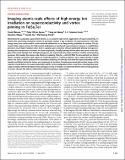Files in this item
Imaging atomic-scale effects of high-energy ion irradiation on superconductivity and vortex pinning in Fe(Se,Te)
Item metadata
| dc.contributor.author | Massee, Freek | |
| dc.contributor.author | Sprau, Peter Oliver | |
| dc.contributor.author | Wang, Yong-Lei | |
| dc.contributor.author | Davis, J. C. Séamus | |
| dc.contributor.author | Ghigo, Gianluca | |
| dc.contributor.author | Gu, Genda D. | |
| dc.contributor.author | Kwok, Wai-Kwong | |
| dc.date.accessioned | 2016-05-12T13:30:04Z | |
| dc.date.available | 2016-05-12T13:30:04Z | |
| dc.date.issued | 2015-05-22 | |
| dc.identifier | 242525234 | |
| dc.identifier | 09eacaa3-3e55-49b4-b35d-fe65ce8b334f | |
| dc.identifier | 26601180 | |
| dc.identifier | 84993930243 | |
| dc.identifier | 000216593600014 | |
| dc.identifier.citation | Massee , F , Sprau , P O , Wang , Y-L , Davis , J C S , Ghigo , G , Gu , G D & Kwok , W-K 2015 , ' Imaging atomic-scale effects of high-energy ion irradiation on superconductivity and vortex pinning in Fe(Se,Te) ' , Science Advances , vol. 1 , no. 4 , e1500033 , pp. 1-6 . https://doi.org/10.1126/sciadv.1500033 | en |
| dc.identifier.issn | 2375-2548 | |
| dc.identifier.uri | https://hdl.handle.net/10023/8791 | |
| dc.description | Experimental studies are supported by the Center for Emergent Superconductivity, an Energy Frontier Research Center, headquartered at Brookhaven National Laboratory and funded by the U.S. Department of Energy, under DE-2009-BNL-PM015. | en |
| dc.description.abstract | Maximizing the sustainable supercurrent density, JC, is crucial to high-current applications of superconductivity. To achieve this, preventing dissipative motion of quantized vortices is key. Irradiation of superconductors with high-energy heavy ions can be used to create nanoscale defects that act as deep pinning potentials for vortices. This approach holds unique promise for high-current applications of iron-based superconductors because J C amplification persists to much higher radiation doses than in cuprate superconductors without significantly altering the superconducting critical temperature. However, for these compounds, virtually nothing is known about the atomic-scale interplay of the crystal damage from the high-energy ions, the superconducting order parameter, and the vortex pinning processes. We visualize the atomic-scale effects of irradiating FeSexTe1-x with 249-MeV Au ions and find two distinct effects: compact nanometer-sized regions of crystal disruption or "columnar defects," plus a higher density of single atomic site "point" defects probably from secondary scattering. We directly show that the superconducting order is virtually annihilated within the former and suppressed by the latter. Simultaneous atomically resolved images of the columnar crystal defects, the superconductivity, and the vortex configurations then reveal how a mixed pinning landscape is created, with the strongest vortex pinning occurring at metallic core columnar defects and secondary pinning at clusters of point-like defects, followed by collective pinning at higher fields. | |
| dc.format.extent | 6 | |
| dc.format.extent | 4186315 | |
| dc.language.iso | eng | |
| dc.relation.ispartof | Science Advances | en |
| dc.subject | Iron-based superconductivity | en |
| dc.subject | Critical current by design | en |
| dc.subject | Spectroscopic imaging scanning tunneling microscopy (SI-STM) | en |
| dc.subject | Vortex pinning | en |
| dc.subject | High energy ion irradation | en |
| dc.subject | QC Physics | en |
| dc.subject | NDAS | en |
| dc.subject.lcc | QC | en |
| dc.title | Imaging atomic-scale effects of high-energy ion irradiation on superconductivity and vortex pinning in Fe(Se,Te) | en |
| dc.type | Journal article | en |
| dc.contributor.sponsor | EPSRC | en |
| dc.contributor.institution | University of St Andrews. School of Physics and Astronomy | en |
| dc.contributor.institution | University of St Andrews. Condensed Matter Physics | en |
| dc.identifier.doi | 10.1126/sciadv.1500033 | |
| dc.description.status | Peer reviewed | en |
| dc.identifier.grantnumber | EP/I031014/1 | en |
This item appears in the following Collection(s)
Items in the St Andrews Research Repository are protected by copyright, with all rights reserved, unless otherwise indicated.

